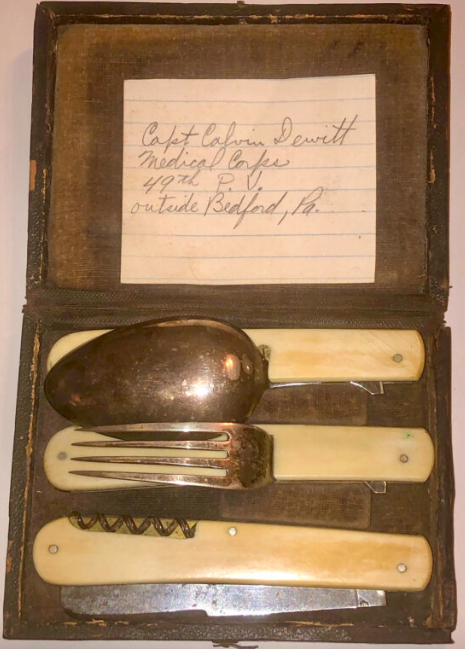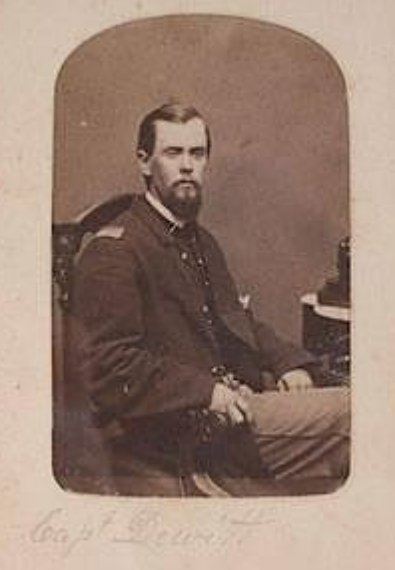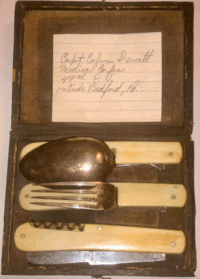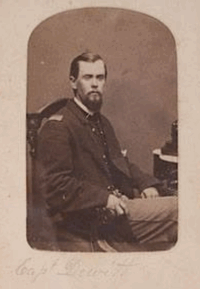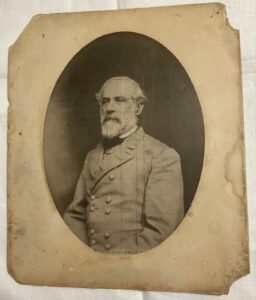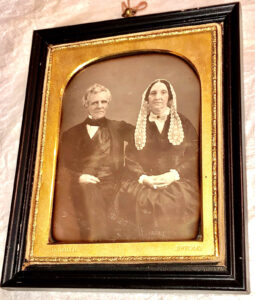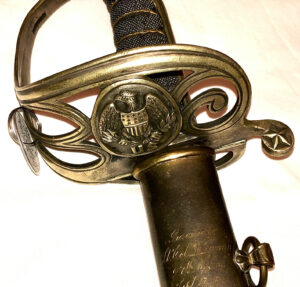High Quality Civil War Id’d Officer’s Traveling Mess Utensils in Original Case
$1,150
High Quality Civil War Id’d Officer’s Traveling Mess Utensils in Original Case – This fine quality, officer grade mess utensils’ kit – folding, knife, fork and spoon – each with ivory-like handles, with each actual utensil constructed of Sheffield, England, hallmarked silver (see below information dating and explaining the hallmarks). The utensils are housed in their original, light wood, carrying case, with a custom designed, interior compartment for each utensil. The interior of the carrying case is lined with an off-purple colored velvet. The exterior of the light wood case is covered with a fine grade of thin leather, comparable to a period image case, with a small, flat, iron, hook closing device. The underside of the case is covered with original, period, marbled paper. Contained in the interior of the carrying case is an old file card with following label, written in pencil:
“Capt. Calvin Dewitt
Medical Corps
49th P.V.
outside Bedford, Pa.”
Dewitt served in the Army of the Potomac during the Civil War, as a Captain, in the 49th Pennsylvania Volunteer Infantry, from October 1861 to January 1863; after 1863, Dewitt saw additional service, during the war, as a surgeon, in the army medical corps. It appears that based upon the date that accrues the hallmarks, Dewitt obtained this kit sometime in late 1864 or early 1865. After the war, he was appointed First Lieutenant, Assistant Surgeon, United States Army, May 14, 1867, and advanced through the grades to Colonel, Assistant Surgeon General, United States Army, May 7, 1901; he would be promoted to the rank of Brigadier General, August 9, 1903 and retire from active service on August 10, 1903. Immediately following the Civil War, Dewitt served as a medical officer in several campaigns against Indians and in Cuba. He was an instructor in military hygiene, at the General Staff College, Fort Leavenworth, Kansas, and professor of military medicine and later president of the Army Medical School, Washington, D.C.
The style and construction of the carrying case and three, silver utensils are indicative of late Civil War period use. Captain Dewitt, upon his death, in recognition of his lengthy and significant Army career, was interred in Arlington Cemetery. This is a finely crafted case, that remains in excellent condition.
Case measures: L – 4.5”; W – 3.5”
Hallmark on the back of each utensil: WH & S B Ltd
The hallmarks on the back of each utensil are indicative of manufacture by William Hutton & Sons, manufacturing silversmiths founded in 1800, in Birmingham, England, transferring to Sheffield in 1832. William Hutton established the firm, and, with the move to Sheffield, they also became platers, having licensed an electroplating technique.
William Hutton & Sons Ltd was not always classed as a limited company, pre-1893 the silverware company that became William Hutton & Sons Ltd started life as simply William Hutton in 1800. It was in 1800 when William Hutton established his silverware firm in Birmingham, which later moved to Sheffield, in 1832, when it became clear that the firm was well and truly active in the silversmith industry. After William’s death, in 1864, the business was continued in the same style by his son William Carr Hutton, the name was subsequently changed to William Hutton & Son, after William Carr Hutton’s death, in 1865.
Calvin DeWitt
| Residence Juniata County PA;
Enlisted on 9/14/1861 as a Captain. On 9/14/1861 he was commissioned into “I” Co. PA 49th Infantry He Resigned on 1/18/1863 (Subsequent service in US Army as Surgeon) Promotions: * Surgeon Other Information: born in Pennsylvania |
49th PA Infantry
( 3-years )
| Organized: Camp Curtin, Harrisburg, PA on 10/1/61 Mustered Out: 7/15/65 at Hall’s Hill, VAOfficers Killed or Mortally Wounded: 9 Officers Died of Disease, Accidents, etc.: 0 Enlisted Men Killed or Mortally Wounded: 184 Enlisted Men Died of Disease, Accidents, etc.: 168 (Source: Fox, Regimental Losses) |
| From | To | Brigade | Division | Corps | Army | Comment |
| Oct ’61 | Mar ’62 | 3 | Smith’s | Army of Potomac | New Organization | |
| Mar ’62 | May ’62 | 1 | 2 | 4 | Army of Potomac | |
| May ’62 | Jan ’63 | 1 | 2 | 6 | Army of Potomac | |
| Feb ’63 | Jul ’64 | 3 | 1 | 6 | Army of Potomac | |
| Aug ’64 | Sep ’64 | Harper’s Ferry: East SH | Reserve | Department of West Virginia | ||
| Sep ’64 | Dec ’64 | 3 | 1 | 6 | Army of the Shenandoah | |
| Dec ’64 | Jul ’65 | 3 | 1 | 6 | Army of Potomac | Mustered Out |
49th Regiment
Pennsylvania Volunteers
Company I
Recruited in Juniata County
| Calvin De Witt | Captain | September 14, 1861 | Resigned January 18, 1863 |
Pennsylvania
49TH INFANTRY
(3 years)
| Forty-ninth Infantry.-Cols., William H. Irwin, Thomas M.
Hulings, B. J. Hickman, A. W. Wakefield; Lieut.-Cols., William Brisbane, Thomas M Hulings, John B. Miles, B. J. Hickman, A. W. Wakefield, James T Stuart; Majs., Thomas M. Hulings, John B. Miles, B. J. Hickman, A.W. Wakefield, James T. Stuart, F. W. Wombacker. The 49th was recruited in the counties of Center, Chester, Huntingdon, Mifflin and Juniata and was mustered into the U. S. service at Camp Curtin, Harrisburg, Sept. 14, 1861, for a three years, term. It was ordered to Washington on Sept. 22, assigned to the 1st brigade of Gen. W. F. Smith’s division, 4th corps, and camped during the winter near Lewinsville. It joined in the campaign on the Peninsula early in 1862, performing various siege duties at Yorktown, and fighting at Williamsburg, Garnett’s and Golding’s farms, White Oak swamp and Malvern hill. On Aug. 16, the regiment was sent to Alexandria, where it was attached to Franklin’s corps, which joined the Army of the Potomac at Centerville and proceeded to Antietam, engaging the enemy on the way at Crampton’s gap. During this battle the 49th was held in reserve, as it was also at Fredericksburg in December. Winter quarters were established at White Oak Church and on Jan. 9, 1864, the regiment was consolidated into a battalion of four companies, which participated in the “Mud March.” Col. Irwin added enough new recruits to the regiment in April to restore it to its old organization and it was assigned to the 3d brigade, 1st division, 6th corps, with which it remained until the end of its service. It was active at Salem Church, present at Deep run, active at Gettysburg, and then joined in the southward movement of the army. It was engaged at Rappahannock Station, and was mentioned in orders for gallantry. It joined in the Mine Run movement, after which it went into winter quarters at Hazel Run, where 260 of its members reenlisted and with the addition of recruits and drafted men the regiment was continued as a veteran organization. On May 4, 1864, it broke camp and the next day the command was in the heat of the action at the Wilderness. At Laurel Hill the regiment made a most daring assault, but at fearful cost. Col. Hulings, Lieut.-Col. Miles 2 other officers and 61 men being killed and 5 officers and 195 men wounded or missing. The next engagement was the assault on the angle at Spotsylvania. The loss up to the 14th of the month when only 130 men were able to report for duty, was 392 killed, wounded or missing. At Cold Harbor the loss was 8 killed and 20 wounded. The regiment proceeded with the army to Petersburg and on July 11, was ordered to Washington, which was threatened by Gen. Early. It followed Early to the Shenandoah river and then returned to Washington, but had scarcely arrived when news of Early’s advance upon Crook caused it to return to Harper’s Ferry. It was active at the battle of Winchester; was posted on guard in the city for a time; then ordered again to Petersburg; shared in the action at Hatcher’s run, and made its winter quarters at Fort Wadsworth. It took part in the final assault on Petersburg; was in the cavalry fight at Sailor’s creek, was then detailed to guard prisoners to Appomattox; next ordered to Danville, where it remained for a month, and then returned to Washington, where it arrived June 2 and remained until mustered out at Hall’s Hill, July 15, 1865. |
49th Pennsylvania Infantry Regiment
| 49th Pennsylvania Volunteer Infantry | |
| Active | September 14, 1861 – July 15, 1865 |
| Country | United States of America |
| Allegiance | Union |
| Branch | Infantry |
| Engagements | Siege of Yorktown Battle of Williamsburg Seven Days Battles Battle of Garnett’s & Golding’s Farm Battle of Savage’s Station Battle of White Oak Swamp Battle of Malvern Hill Battle of South Mountain Battle of Antietam Battle of Fredericksburg Battle of Chancellorsville Battle of Gettysburg Bristoe Campaign Second Battle of Rappahannock Station Mine Run Campaign Battle of Germanna Ford Battle of the Wilderness Battle of Spotsylvania Court House Battle of North Anna Battle of Cold Harbor Siege of Petersburg Battle of Fort Stevens Third Battle of Winchester Battle of Hatcher’s Run Appomattox Campaign Third Battle of Petersburg Battle of Sailor’s Creek |
The 49th Pennsylvania Volunteer Infantry was an infantry regiment that served in the Union Army during the American Civil War.
Service
The 49th Pennsylvania Infantry was organized in Lewistown and Harrisburg, Pennsylvania and mustered in September 14, 1861 at Camp Curtin for a three-year enlistment under the command of Colonel William H. Irwin.
The regiment was attached to Hancock’s Brigade, W. F. Smith’s Division, Army of the Potomac, to March 1862. 1st Brigade, 2nd Division, IV Corps, Army of the Potomac, to May 1862. 1st Brigade, 2nd Division, VI Corps, Army of the Potomac, to February 1863. 3rd Brigade, 1st Division, VI Corps, to July 1864. 3rd Brigade, 1st Division, VI Corps, Army of the Shenandoah, to August 1864. Reserve Division, Department of West Virginia, to September 1864. 3rd Brigade, 1st Division, VI Corps, Army of the Shenandoah, to December 1864, and Army of the Potomac, to July 1865.
The 49th Pennsylvania Infantry mustered out July 15, 1865.
Detailed service
Left Pennsylvania for Washington, D.C., September 22, 1861. Duty near Lewinsville, Va., defenses of Washington, D.C., until March 1862. Advance on Manassas, Va., March 10-15. Return to Alexandria and embark for the Virginia Peninsula. Siege of Yorktown April 5-May 4. Lee’s Mills, Burnt Chimneys, April 16. Battle of Williamsburg May 5. Pursuit to the Chickahominy River and picket duty until June 25. Seven Days Battles before Richmond June 25-July 1. Garnett’s Farm June 27. Golding’s Farm June 28. Savage Station June 29. White Oak Swamp Bridge June 30. Malvern Hill July 1. At Harrison’s Landing until August 16. Movement to Centreville August 16-27. In works at Centreville August 27-31. Assist in checking Pope’s rout at Bull Run August 30, and cover retreat to Fairfax Court House August 31-September 1. Maryland Campaign September 6-24. Sugar Loaf Mountain September 10-11. Crampton’s Pass, South Mountain, September 14. Battle of Antietam September 16-17. Duty in Maryland until October 29. Movement to Falmouth, Va., October 29-November 19. Battle of Fredericksburg December 12-15. Consolidated to four companies January 9, 1863. “Mud March” January 20-24. At White Oak Church until April 27. Chancellorsville Campaign April 27-May 6. Operations at Franklin’s Crossing April 29-May 2. Bernard House April 29. Maryes Heights, Fredericksburg, May 3. Salem Heights May 3-4. Banks’ Ford May 4. At White Oak Church until June 6. Deep Run Ravine June 6-13. Battle of Gettysburg, Pa., July 2-4. At and near Funkstown, Md., July 10-13. Duty on line of the Rappahannock until October. Bristoe Campaign October 9-22. Advance to line of the Rappahannock November 7-8. Rappahannock Station November 7. Mine Run Campaign November 26-December 2. Duty at Hazel River until May 1864. Rapidan Campaign May 4-June 13. Battle of the Wilderness May 5-7, Spottsylvania May 8-12, Spottsylvania Court House May 12-21. Assault on the Salient May 12. North Anna River May 23-26. On line of the Pamunkey May 26-28. Totopotomoy May 28-31. Cold Harbor May 31-June 12. Before Petersburg June 17-19. Siege of Petersburg June 17-July 9. Jerusalem Plank Road, Weldon Railroad, June 22-23. Moved to Washington, D.C., July 9-11. Repulse of Early’s attack on Washington July 12-13. Pursuit of Early July 14-18. Sheridan’s Shenandoah Valley Campaign August to December. Third Battle of Winchester, September 19. Guard duty at Winchester until October 29, and in the valley until December 1. Ordered to Petersburg, Va. Siege operations against Petersburg December 1864 to April 1865. Dabney’s Mills, Hatcher’s Run, February 5-7, 1865. Appomattox Campaign March 28-April 9. Assault on and fall of Petersburg April 2. Sailor’s Creek April 6. Detached to escort prisoners April 6. March to Danville April 23-29, and duty there until May 23. Moved to Richmond, Va., then to Washington, D.C. Corps review June 8. Duty at Hall’s Hill until July 15.
Casualties
The regiment lost a total of 361 men during service; 9 officers and 184 enlisted men killed or mortally wounded, 168 enlisted men died of disease.
Commanders
- Colonel William H. Irwin – resigned October 24, 1863
- Colonel Thomas M. Hulings – killed in action at the Battle of Spotsylvania Court House
- Lieutenant ColonelWilliam Brisbane – commanded at the Battle of Antietam
- Lieutenant Colonel Baynton J. Hickman – commanded at the Third Battle of Winchester
Notable members
- CaptainWilliam Earnshaw, regimental chaplain – 8th Commander-in-Chief, Grand Army of the Republic (1879-1880)
- DrummerCharles E. King, Company F – mortally wounded in action at the Battle of Antietam; youngest-documented soldier to be killed during the Civil War
| Calvin DeWitt Brigadier General, United States Army |
|
| Calvin Dewitt of Pennsylvania Appointed from Pennsyvlania, Captain, 49th Pennsylvania Infantry, 24 October 1861 Resigned 18 January 1863 Assistant Surgeon, U. S. Army, 14 May 1867 Major, Surgeon, U. S. Army, 21 July 1885 Lieutenant Colonel, Deputy Surgeon General, U. S. Army, 15 December 1898 Colonel, Assistant Surgeon General, U. S. Army, 7 May 1901 Born at Harrisburg, Pennsylvania, May 26, 1840, the son of the Reverend William R. and Mary Elizabeth (Wallace) DeWitt. He was educated at Harrisburg Academy: A.B. at Princeton, 1860; AM in 1863 and MD in 1865 from Jefferson Medical College, Philadelphia. Married Josephine Lesesne in 1877.He served in the Army of the Potomac in the Civil War; Captain, 49th Pennsylvania Volunteer Infantry, October 1861-January 1863; appointed First Lieutenant, Assistant Surgeon, United States Army, May 14, 1867, and advanced through the grades to Colonel, Assistant Surgeon General, United States Army, May 7, 1901; to Brigadier General, August 9, 1903 and retired from active service on August 10, 1903. He served as a medical officer in several campaigns against Indians and in Cuba. Was an intructor in military hygiene, General Staff College, Fort Leavenworth, Kansas, and professor of military medicine and later president, Army Medical School, Washington, D.C. He died in 1908 and was buried in Section 3 of Arlington National Cemetery. His wife, Josephine Lesesne Dewitt (1856-1952) outlived him by 44 years, never remarried and is buried with him. His sons, John Lesesne DeWitt, Lieutenant General, United States Army; Calvin DeWitt, Jr., Brigadier General, United States Army; and Wallace DeWitt, Brigadier General, United States Army, are also buried in Arlington National Cemetery. In addition, his Grandsons, John Lesene Dewitt, Jr., Lieutenant Colonel, United States Army, and Wallace DeWitt, Jr., Major, United States Army, are also buried in Arlington National Cemetery. DEWITT, CALVIN DEWITT, JOSEPHINE L WID OF DE WITT, CALVIN D |

